Small Strain Stiffness of Unsaturated Sands Containing a Polyacrylamide Solution
Abstract
:1. Introduction
2. Experimental Study
2.1. Materials
2.2. Experimental Procedure
3. Results and Discussion
3.1. Water Retention Curves
3.2. Shear Wave Velocity
3.3. Capillary Pressure Effects
4. Conclusions
Acknowledgments
Author Contributions
Conflicts of Interest
References
- Briscoe, W.H.; Klein, J. Friction and adhesion hysteresis between surfactant monolayers in water. J. Adhes. 2007, 83, 705–722. [Google Scholar] [CrossRef]
- Yoshizawa, H.; Chen, Y.L.; Israelachvili, J. Fundamental mechanisms of interfacial friction. 1. Relation between adhesion and friction. J. Phys. Chem. 1993, 97, 4128–4140. [Google Scholar] [CrossRef]
- Bate, B.; Zhao, Q.; Burns, S. Impact of organic coatings on frictional strength of organically modified clay. J. Geotech. Geoenviron. Eng. 2013, 140, 228–236. [Google Scholar] [CrossRef]
- Jung, J.; Jang, J.; Ahn, J. Characterization of a polyacrylamide solution used for remediation of petroleum contaminated soils. Materials 2016, 9, 16. [Google Scholar] [CrossRef]
- Kang, J.; Sowers, T.D.; Duckworth, O.W.; Amoozegar, A.; Heitman, J.L.; Mclaughlin, R.A. Turbidimetric determination of anionic polyacrylamide in low carbon soil extracts. J. Environ. Qual. 2013, 42, 1902–1907. [Google Scholar] [CrossRef] [PubMed]
- Martin, G.; Yen, T.; Karimi, S. Application of biopolymer technology in silty soil matrices to form impervious barriers. Proceeding of the Conference on 7th Australia New Zealand Conference on Geomechanics: Geomecahnics in a Changing Wolrd, Barton, Australia, 1–5 July 1996; pp. 814–819. [Google Scholar]
- Kavazanjian, E.; Iglesias, E.; Karatas, I. Biopolymer soil stabilization for wind erosion control. Proceeding of the Conference on the 17th International Conference on Soil Mechanics and Geotechnical Engineering, Alexandria, Egypt, 5–9 October 2009; Hamza, M., Shahien, M., El-Mossallamy, Y., Eds.; pp. 881–884. [Google Scholar]
- Cabalar, A.F.; Canakci, H. Ground improvement by bacteria. Proceeding of the Conference on the 3rd Biot Conference on Poromechanics, Norman, OK, USA, 24–27 May 2005; pp. 707–712. [Google Scholar]
- Nugent, R.; Zhang, G.; Gambrell, R. Effect of exopolymers on the liquid limit of clays and its engineering implications. J. Transp. Res. Board 2009, 2101, 34–43. [Google Scholar] [CrossRef]
- Sojka, R.E.; Bjorneberg, D.L.; Entry, J.A.; Lentz, R.D.; Orts, W.J. Polyacrylamide in agriculture and environmental land management. Adv. Agron. 2007, 92, 75–162. [Google Scholar]
- Inbar, A.; Ben-Hur, M.; Sternberg, M.; Lado, M. Using polyacrylamide to mitigate post-fire soil erosion. Geoderma 2015, 239–240, 107–114. [Google Scholar] [CrossRef]
- Lentz, R.D. Polyacrylamide and biopolymer effects on flocculation, aggregate stability, and water seepage in a silt loam. Geoderma 2015, 241–242, 289–294. [Google Scholar] [CrossRef]
- Lee, S.S.; Shah, H.S.; Awad, Y.M.; Kumar, S.; Ok, Y.S. Synergy effects of biochar and polyacrylamide on plants growth and soil erosion control. Environ. Earth Sci. 2015, 74, 1–11. [Google Scholar] [CrossRef]
- Mamedov, A.; Wagner, L.; Huang, C.; Norton, L.; Levy, G. Polyacrylamide effects on aggregate and structure stability of soils with different clay mineralogy. Soil Sci. Soc. Am. J. 2010, 74, 1720–1732. [Google Scholar] [CrossRef]
- Van Genuchten, M.T. A closed-form equation for predicting the hydraulic conductivity of unsaturated soils. Soil Sci. Soc. Am. J. 1980, 44, 892–898. [Google Scholar] [CrossRef]
- Assouline, S. A model for soil relative hydraulic conductivity based on the water retention characteristic curve. Water Resour. Res. 2001, 37, 265–271. [Google Scholar] [CrossRef]
- Campbell, G.S. A simple method for determining unsaturated conductivity from moisture retention data. Soil Sci. 1974, 117, 311–314. [Google Scholar] [CrossRef]
- Fischer, U.; Celia, M.A. Prediction of relative and absolute permeabilities for gas and water from soil water retention curves using a pore-scale network model. Water Resour. Res. 1999, 35, 1089–1100. [Google Scholar] [CrossRef]
- Mualem, Y. Hydraulic conductivity of unsaturated soils: Prediction and formulas. Agronomy 1986, 9, 799–823. [Google Scholar]
- Vogel, T.; Cislerova, M. On the reliability of unsaturated hydraulic conductivity calculated from the moisture retention curve. Transp. Porous Media 1988, 3, 1–15. [Google Scholar] [CrossRef]
- Zhao, X. Measurements and Transient Multistep Outflow Simulation of Soil-Water Characteristic Curve for Soils Modified with Biopolymers. Master’s Thesis, Missouri University of Science and Technology, Rolla, MO, USA, January 2014. [Google Scholar]
- Javadi, S.; Ghavami, M.; Zhao, Q.; Bate, B. Advection and retardation of non-polar contaminants in compacted clay barrier material with organoclay amendment. Appl. Clay Sci. 2016, in press. [Google Scholar] [CrossRef]
- Brady, N.C.; Weil, R.R. Elements of the Nature and Properties of Soils; Pearson Prentice Hall: Upper Saddle River, NJ, USA, 2010. [Google Scholar]
- Fredlund, D.G.; Xing, A.; Fredlund, M.D.; Barbour, S.L. The relationship of the unsaturated soil shear to the soil-water characteristic curve. Can. Geotech. J. 1996, 33, 440–448. [Google Scholar] [CrossRef]
- Öberg, A.L.; Sällfors, G. Determination of shear strength parameters of unsaturated silts and sands based on the water retention curve. Can. Geotech. J. 1997, 20, 40–48. [Google Scholar]
- Vanapalli, S.K.; Fredlund, D.G.; Pufahl, D.E.; Clifton, A.W. Model for the prediction of shear strength with respect to soil suction. Can. Geotech. J. 1996, 33, 379–392. [Google Scholar] [CrossRef]
- Delage, P.; Howat, M.; Cui, Y. The relationship between suction and swelling properties in a heavily compacted unsaturated clay. Eng. Geol. 1998, 50, 31–48. [Google Scholar] [CrossRef]
- Gens, A.; Alonso, E.E. A framework for the behaviour of unsaturated expansive clays. Can. Geotech. J. 1992, 29, 1013–1032. [Google Scholar] [CrossRef]
- Pedarla, A.; Puppala, A.J.; Hoyos, L.R.; Vanapalli, S.K.; Zapata, C. Unsaturated soils: Research and Applications; Springer: Berlin, Germany, 2012; pp. 221–228. [Google Scholar]
- Kang, X.; Bate, B. Shear wave velocity and its anisotropy of polymer modified high volume class F fly ash-kaolinite mixtures. J. Geotech. Geoenviron. Eng. 2016, 142, 04016068. [Google Scholar] [CrossRef]
- Kang, X.; Kang, G.-C.; Bate, B. Shear wave velocity anisotropy of kaolinite using a floating wall consolidometer-type bender element testing system. Geotech Test. J. 2014, 37, 869–883. [Google Scholar] [CrossRef]
- Lee, J.S.; Santamarina, J.C. Bender elements: Performance and signal interpretation. J. Geotech. Geoenviron. Eng. 2005, 131, 1063–1070. [Google Scholar] [CrossRef]
- Haines, W.B. Studies in the physical properties of soil. V. The hysteresis effect in capillary properties, and the modes of moisture distribution associated therewith. J. Agric. Sci. 1930, 20, 97–116. [Google Scholar] [CrossRef]
- Tokunaga, T.K.; Wan, J.; Olson, K.R. Saturation-matric potential relations in gravel. Water Resour. Res. 2002, 38, 32-1–32-7. [Google Scholar] [CrossRef]
- ASTM Standard D 6836. Test Methods for Determination of the Soil Water Characteristic Curve for Desorption using a Hanging Column, Pressure Extractor, Chilled Mirror Hygrometer, And/Or Centrifuge; Annual Book of ASTM Standards; ASTM: West Conshohocken, PA, USA, 2003; Volume 04.08. [Google Scholar]
- Jung, J.; Jang, J. Soil-water characteristic curve of sediments containing a polyacrylamide solution. Geotech. Lett. 2016, 6, 1–6. [Google Scholar] [CrossRef]
- Sillers, W.S.; Fredlund, D.G.; Zakerzadeh, N. Mathematical attributes of some soil—water characteristic curve models. Geotech. Geol. Eng. 2001, 19, 243–283. [Google Scholar] [CrossRef]
- Yang, H.; Rahardjo, H.; Leong, E.C.; Fredlund, D.G. Factors affecting drying and wetting soil-water characteristic curves of sandy soils. Can. Geotech. J. 2004, 41, 908–920. [Google Scholar] [CrossRef]
- Zhou, J.; Yu, J.L. Influences affecting the soil-water characteristic curve. J. Zhejiang Univ. Sci. 2005, 6, 797–804. [Google Scholar] [CrossRef]
- Gittins, P.; Iglauer, S.; Pentland, C.H.; Al-Mansoori, S.; Al-Sayari, S.; Bijeljic, B.; Blunt, M.J. Nonwetting phase residual saturation in sand packs. J. Porous Media 2010, 13, 591–599. [Google Scholar] [CrossRef]
- Schroth, M.; Istok, J.; Ahearn, S.; Selker, J. Characterization of Miller-similar silica sands for laboratory hydrologic studies. Soil Sci. Soc. Am. J. 1996, 60, 1331–1339. [Google Scholar] [CrossRef]
- Cho, G.C.; Santamarina, J.C. Unsaturated particulate materials—Particle-Level Studies. J. Geotech. Geoenviron. Eng. 2001, 127, 84–96. [Google Scholar] [CrossRef]
- Alramahi, B.; Alshibli, K.A.; Fratta, D.; Trautwein, S. A suction-control apparatus for the measurement of P and S wave velocity in soil. Geotech. Test. J. 2008, 31, 1–12. [Google Scholar]
- Roesler, S.K. Anisotropic shear modulus due to stress anisotropy. J. Geochem. Eng. 1978, 105, 871–880. [Google Scholar]
- Santamarina, J.C.; Klein, K.; Fam, M. Soils and waves: Particulate materials behavior, characterization and process monitoring. J. Soils Sediments 2001, 1, 130. [Google Scholar] [CrossRef]
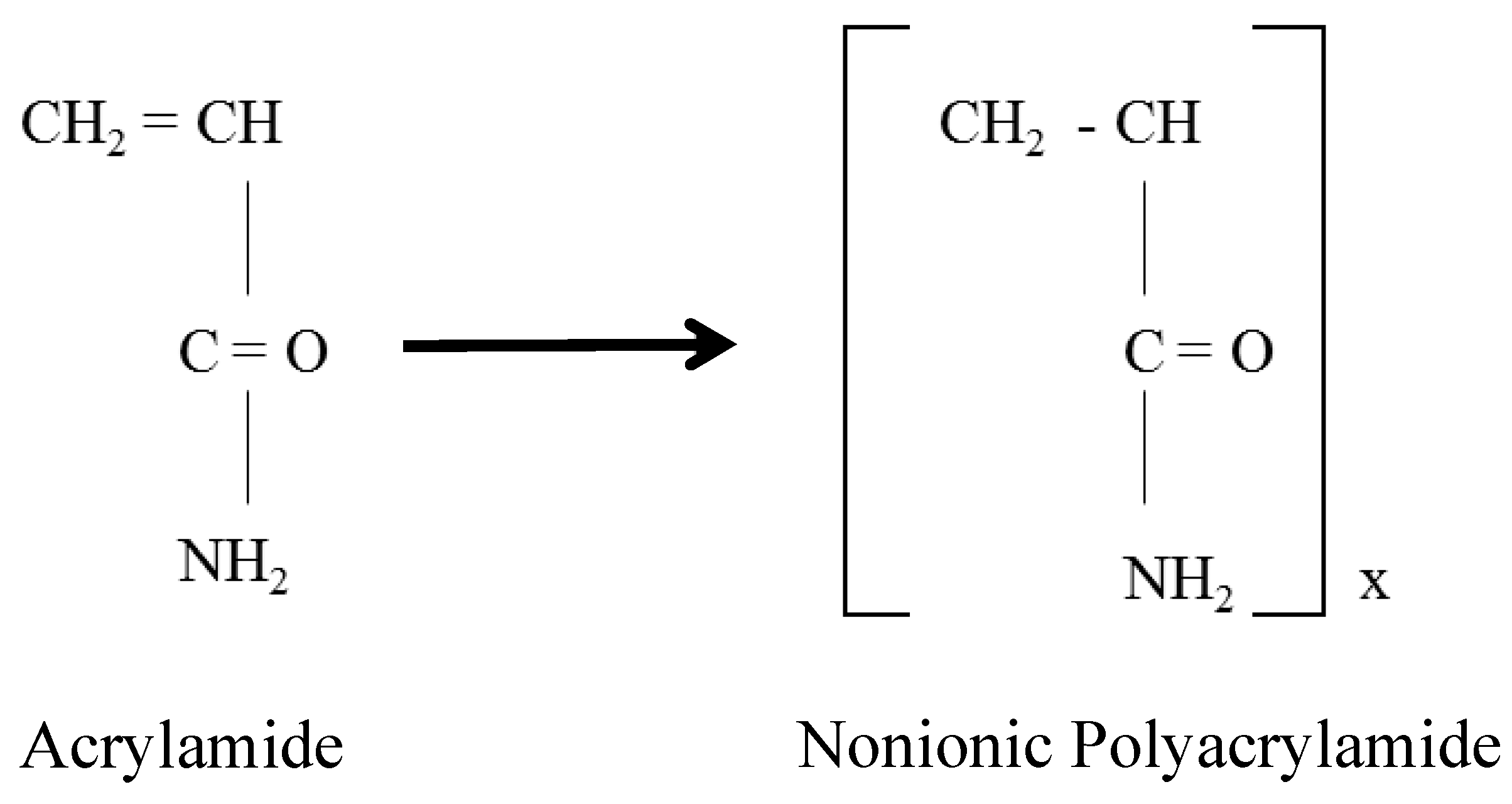

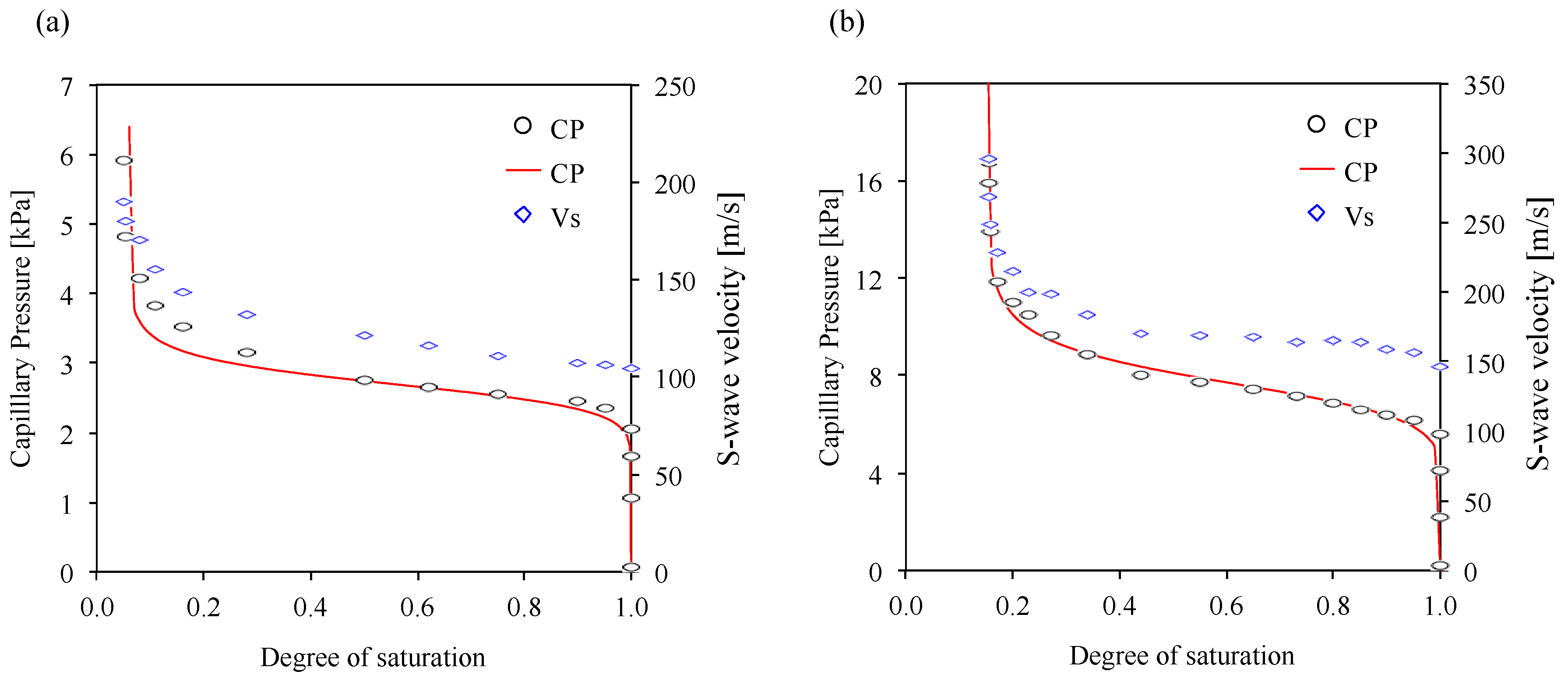
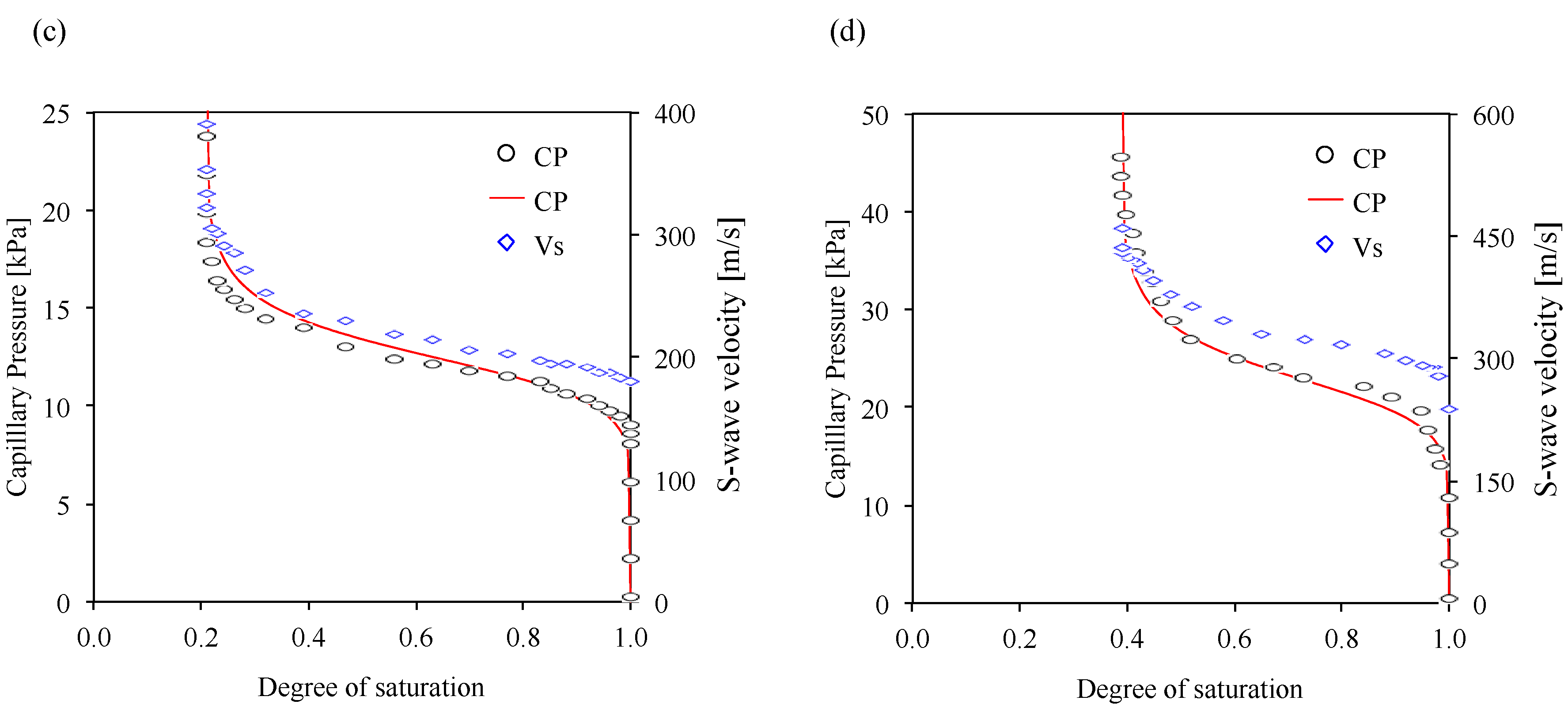
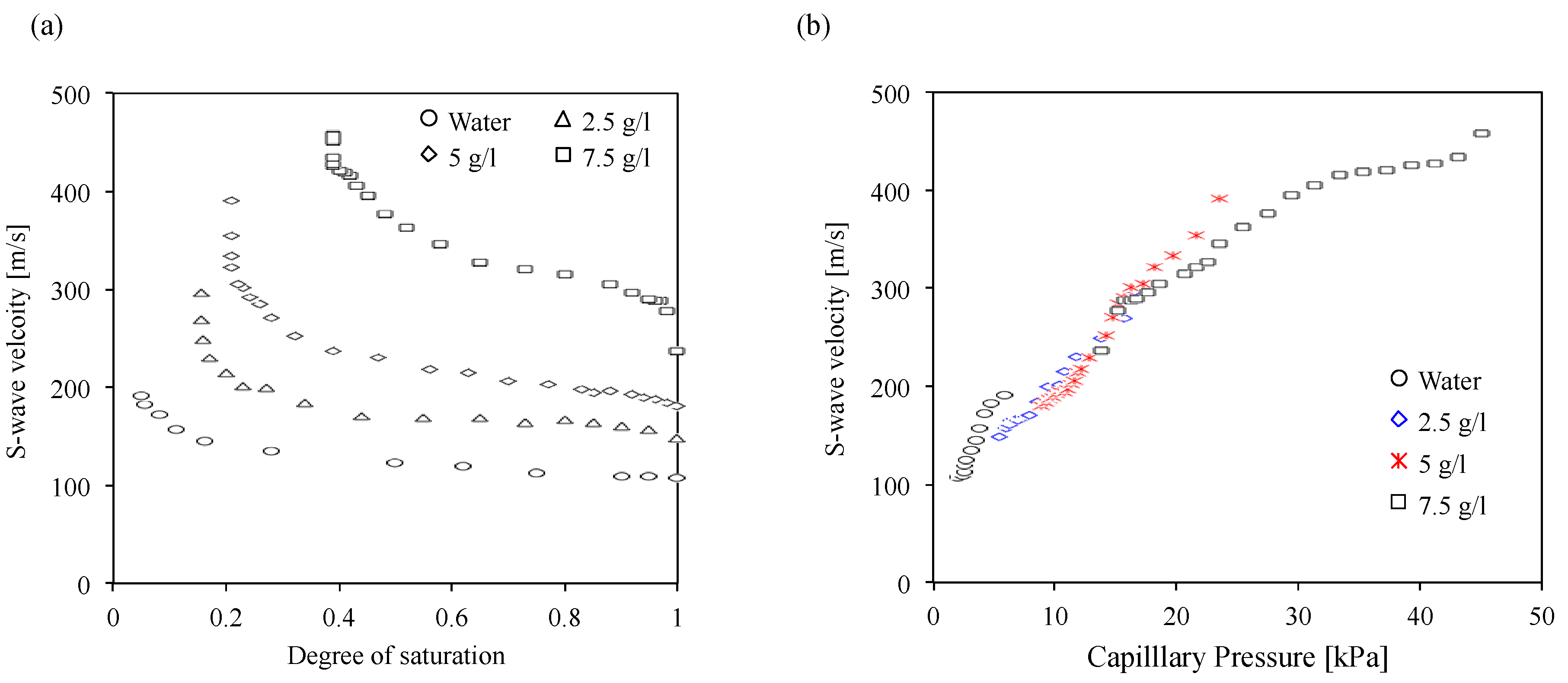
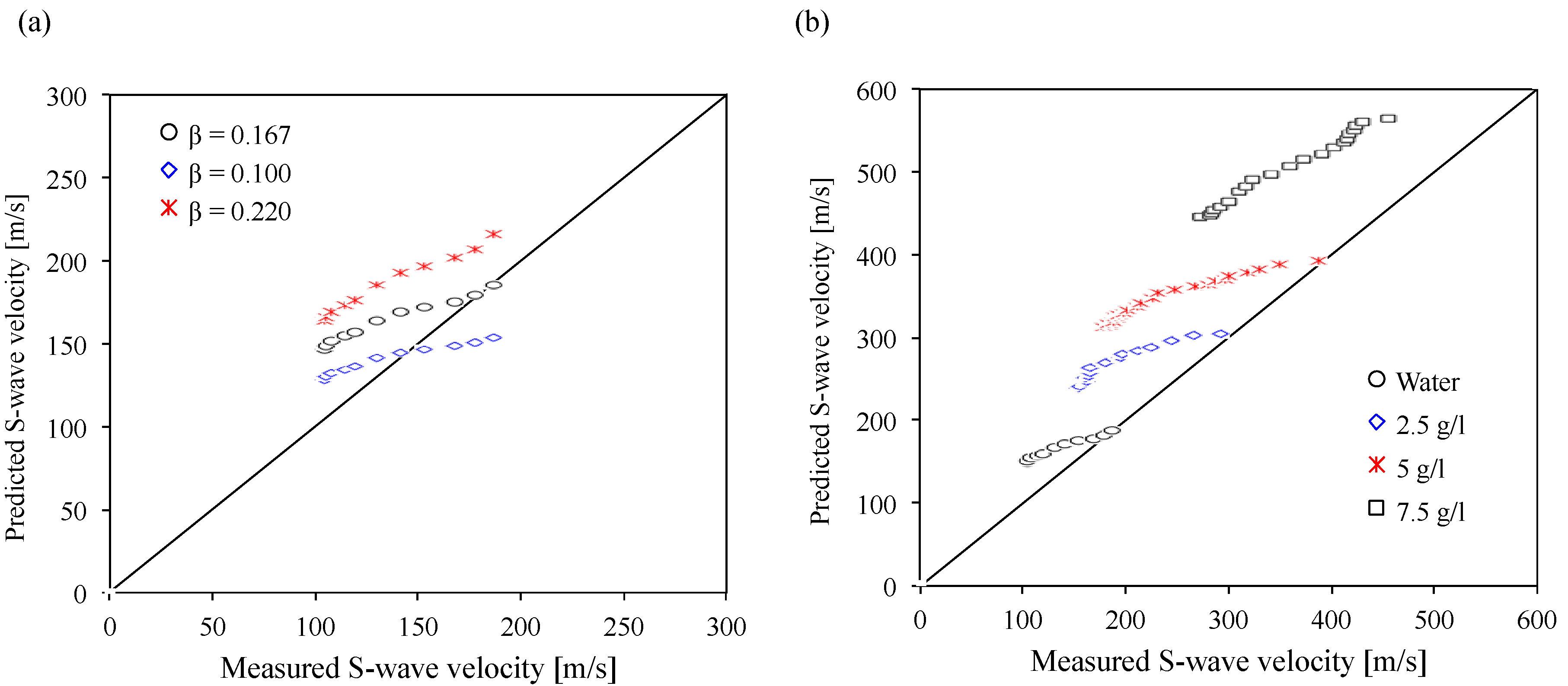
© 2017 by the authors. Licensee MDPI, Basel, Switzerland. This article is an open access article distributed under the terms and conditions of the Creative Commons Attribution (CC BY) license (http://creativecommons.org/licenses/by/4.0/).
Share and Cite
Jung, J.; Ku, T.; Ahn, J. Small Strain Stiffness of Unsaturated Sands Containing a Polyacrylamide Solution. Materials 2017, 10, 401. https://doi.org/10.3390/ma10040401
Jung J, Ku T, Ahn J. Small Strain Stiffness of Unsaturated Sands Containing a Polyacrylamide Solution. Materials. 2017; 10(4):401. https://doi.org/10.3390/ma10040401
Chicago/Turabian StyleJung, Jongwon, Taeseo Ku, and Jaehun Ahn. 2017. "Small Strain Stiffness of Unsaturated Sands Containing a Polyacrylamide Solution" Materials 10, no. 4: 401. https://doi.org/10.3390/ma10040401





